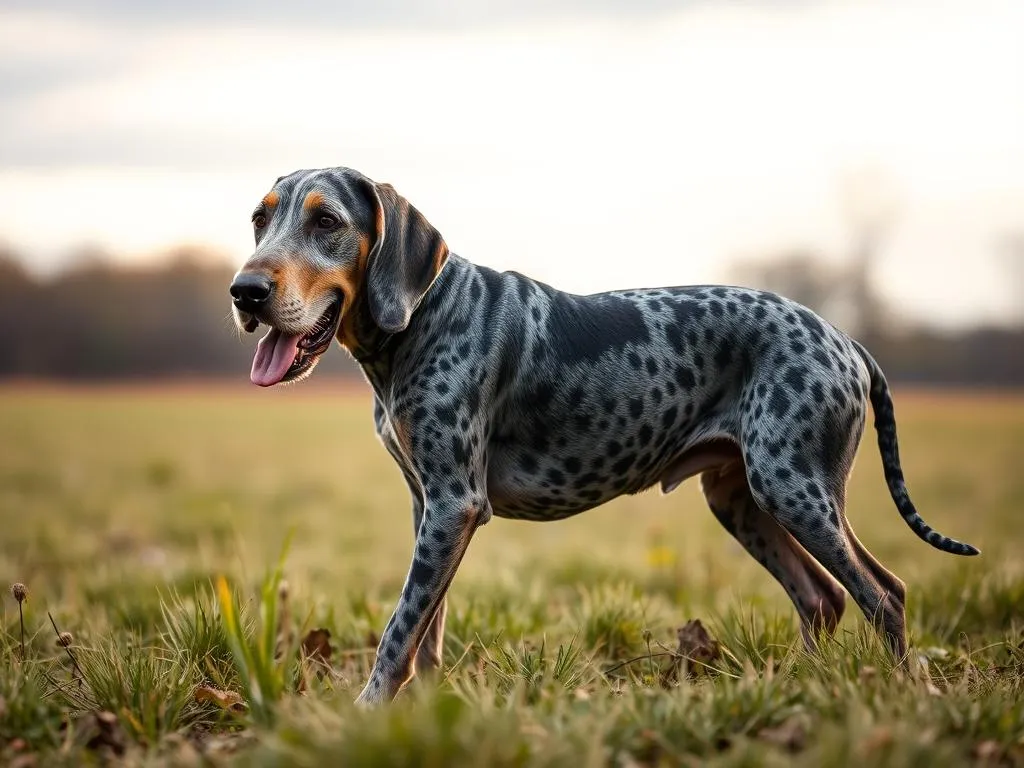
Introduction
Dog breeds are an essential part of human companionship, offering a range of traits and characteristics that appeal to different lifestyles and preferences. Among these breeds, the Bluetick Coonhound stands out due to its unique history, physical traits, and temperament. This breed has roots that trace back to the southern United States, where it has played a vital role in hunting and companionship. Understanding the Bluetick Coonhound is crucial for potential owners, as each breed comes with its own set of needs and characteristics that can significantly impact home life.
History of the Bluetick Coonhound
Origins
The Bluetick Coonhound has a rich ancestry that can be traced back to the 18th century. This breed is a descendant of various hounds, including the English Coonhound and the French Bluetick, which contributed to its distinctive coat and tracking abilities. The breed was developed primarily for hunting game, particularly raccoons, and its lineage reflects a blend of both European and American hunting traditions.
Historical Roles
Historically, the Bluetick Coonhound has been renowned for its exceptional hunting and tracking skills. These dogs were bred to work long hours in the woods, often trailing raccoons or other small game. Their keen sense of smell and vocal abilities made them invaluable to hunters. Culturally, they hold a significant place in southern folklore, where they are celebrated for their loyalty and companionship, often seen as trusted partners in both hunting and family life.
Recognition
The Bluetick Coonhound gained official breed recognition from major kennel clubs, such as the American Kennel Club (AKC) and the United Kennel Club (UKC). The AKC recognized the breed in 2009, highlighting its popularity and the need for responsible breeding practices.
Physical Characteristics
Size and Weight
The Bluetick Coonhound is a medium to large-sized dog. Males typically stand between 22 to 27 inches tall at the shoulder, while females range from 21 to 25 inches. In terms of weight, males usually weigh between 50 to 75 pounds, and females weigh about 40 to 65 pounds. Their sturdy build and athleticism make them well-suited for their traditional roles as hunting companions.
Coat and Color
The coat of the Bluetick Coonhound is one of its most recognizable features. It is short, dense, and typically has a unique bluish-gray color with black spots, also known as “ticking.” The ticking pattern can vary in intensity, creating a stunning visual effect. Their coat is relatively low-maintenance, requiring only occasional brushing to remove loose hairs and dirt.
Distinctive Features
In addition to their striking coat, Bluetick Coonhounds possess several distinctive physical traits. They have long, droopy ears that help funnel scents towards their noses, enhancing their tracking abilities. Their eyes are typically a warm brown, conveying an intelligent and friendly expression. The breed’s strong, muscular build is designed for endurance, making them excellent companions for active families.
Temperament and Behavior
General Temperament
The Bluetick Coonhound is known for its friendly and loyal nature. They are affectionate with their families and tend to form strong bonds with their owners. This breed is also energetic and requires regular exercise to stay happy and healthy. Their playful demeanor makes them great companions for children and active individuals.
Behavior with Families
When it comes to family interactions, Bluetick Coonhounds are typically gentle and patient. They are known to be good with children, often displaying a protective instinct. However, due to their hunting background, they may have a strong prey drive, so supervision around smaller pets is advisable. Early socialization helps them learn to coexist peacefully with other animals.
Intelligence and Trainability
Intelligent and eager to please, the Bluetick Coonhound can be trained successfully with the right approach. However, they may also exhibit a stubborn streak, making consistent training essential. Positive reinforcement techniques, such as treats and praise, work best. Starting training at an early age helps establish good behavior patterns and strengthens the bond between the dog and its owner.
Health and Care
Common Health Issues
As with any breed, the Bluetick Coonhound is prone to certain genetic health issues. Common concerns include hip dysplasia, ear infections due to their floppy ears, and certain eye conditions like cataracts. Regular veterinary check-ups help catch any health issues early, ensuring a long and healthy life for your pet.
Regular Care Needs
Grooming the Bluetick Coonhound is relatively straightforward. Their short coat requires minimal upkeep, needing only occasional brushing to eliminate loose hair and debris. Bathing should be done as needed, but over-bathing can strip their coat of natural oils. Additionally, regular ear cleaning is crucial to prevent infections.
In terms of exercise, the Bluetick Coonhound is an active breed that requires ample physical activity. Daily walks, playtime, and opportunities to run in a safe environment are important to meet their exercise needs. A bored Bluetick can develop behavioral issues, so keeping them engaged is key.
Nutrition
A well-balanced diet is vital for the health of a Bluetick Coonhound. High-quality commercial dog food that meets their nutritional needs is recommended, especially food formulated for active breeds. Portion control is important to prevent obesity, and it’s essential to adjust feeding based on age, activity level, and weight.
Training and Socialization
Importance of Early Training
Starting training early is crucial for a Bluetick Coonhound. Puppies are like sponges, soaking up information and experiences. Early training helps them understand boundaries and develop good manners, making them more enjoyable companions as they grow.
Effective Training Techniques
Positive reinforcement is the most effective training method for this breed. Using treats, praise, and playtime as rewards encourages them to learn and obey commands. Keeping training sessions short and engaging is vital, as Bluetick Coonhounds can lose focus if sessions are too lengthy or monotonous.
Socialization Practices
Socializing a Bluetick Coonhound from a young age helps them become well-rounded adults. Exposing them to various environments, people, and other animals can reduce anxiety and promote confidence. Puppy classes and dog parks are excellent venues for socialization, allowing them to interact in a controlled setting.
Living with a Bluetick Coonhound
Ideal Living Conditions
The Bluetick Coonhound thrives in an environment where it can be active. They do well in homes with yards where they can run and play. While they can adapt to apartment living, regular access to outdoor spaces is essential to meet their exercise needs.
Time Commitment
Owning a Bluetick Coonhound requires a significant time commitment. Daily exercise is essential, along with quality time spent with the dog. They are social animals and thrive on companionship, so ensuring they receive ample attention is crucial for their mental well-being.
Activities and Enrichment
Engaging activities are vital for a Bluetick Coonhound. This breed enjoys hiking, running, and playing fetch, making them perfect companions for outdoor enthusiasts. Additionally, they may excel in dog sports such as agility or scent work, providing mental stimulation and physical exercise.
Pros and Cons of Owning a Bluetick Coonhound
Advantages
The Bluetick Coonhound has many appealing traits, making them great companions. Their friendly disposition, loyalty, and love for family activities make them excellent family pets. They are also intelligent and versatile, able to participate in various activities, from hunting to dog sports.
Challenges
However, potential owners should consider the challenges of owning a Bluetick Coonhound. They can be vocal, with a tendency to bark, which might not be suitable for all living situations. Their stubbornness can also make training a challenge, requiring patience and consistency. Additionally, their high energy levels mean they need ample exercise, which may not fit all lifestyles.
Conclusion
In summary, the Bluetick Coonhound is a unique and engaging breed, known for its striking appearance and friendly temperament. Potential owners should carefully assess their lifestyle and commitment to ensure that they can meet the needs of this active breed. The joy of having a Bluetick Coonhound as part of the family is immense, offering companionship, loyalty, and a zest for life that enriches the lives of those around them. Whether you’re an avid hunter or simply enjoy an active lifestyle, the Bluetick Coonhound could be the perfect addition to your home.









